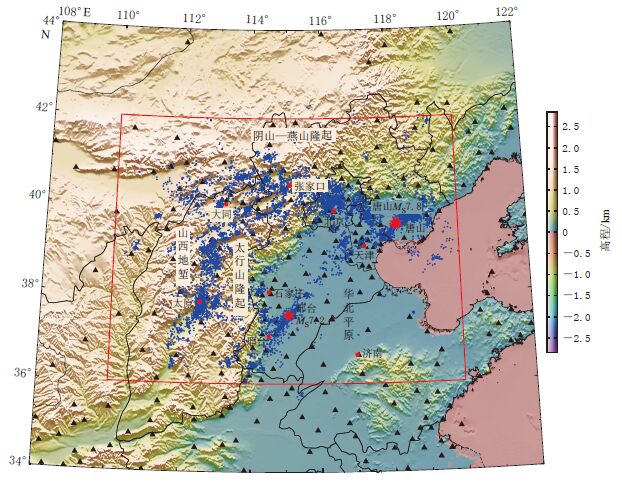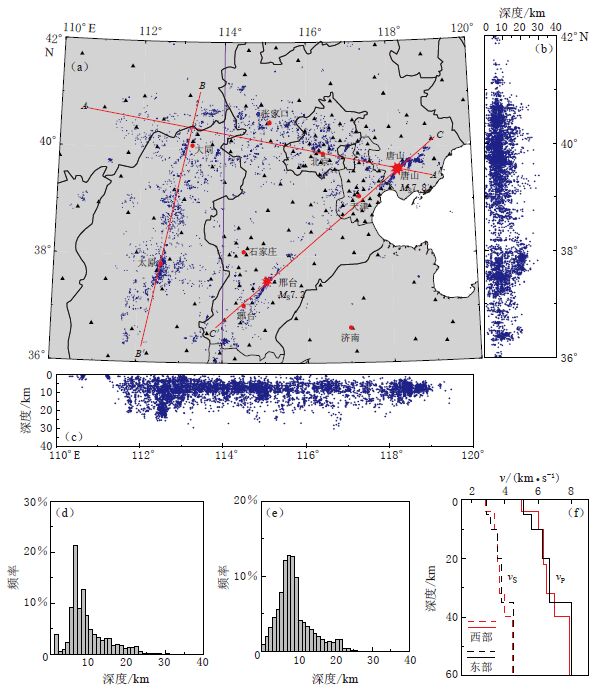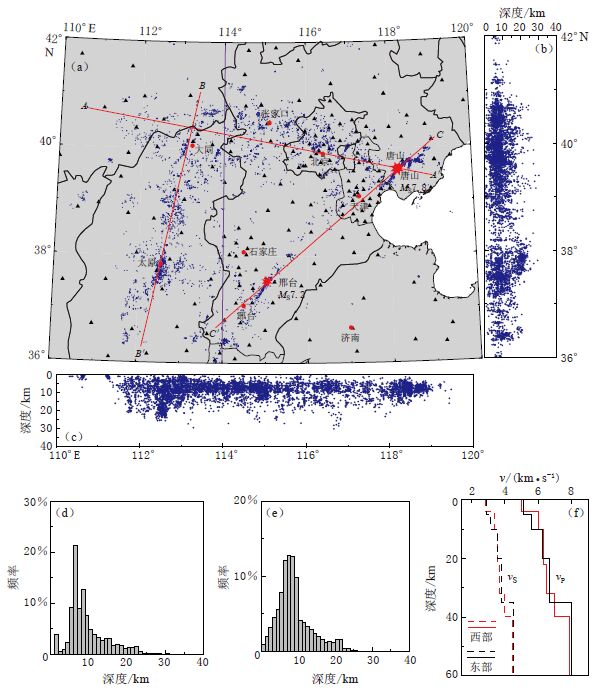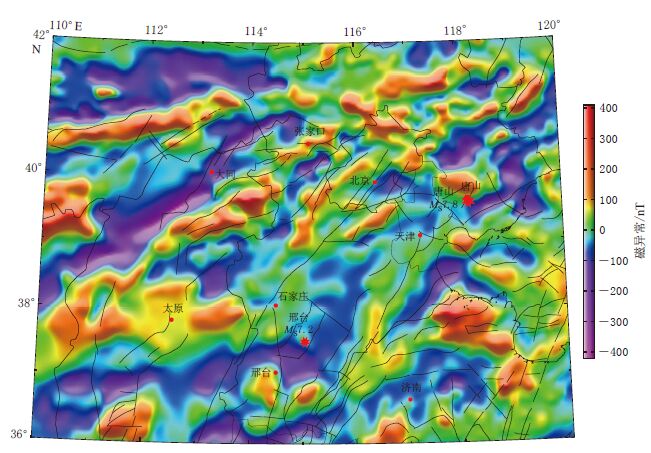Relationship between seismicity and crustal thermal structure in North China
-
摘要: 本文应用双差定位法对2009—2015年华北地区发生的地震进行了重新定位, 共得到6225次地震的精确定位结果. 结果显示, 重定位后的小震更加集中分布于断裂附近, 震源深度多为5—15 km. 利用基于三维分形磁化模型的中心点法获得了华北地区的居里点深度并计算了磁性层的平均地温梯度, 进而利用随温度变化的热导率一维稳态热传导方程获得了华北地区的地壳温度结构. 结果显示: ① 除张渤地震带中东部地区以外, 大多数地震均发生在地温梯度较小的地方; ② 1966年邢台MS7.2地震和1976年唐山MS7.8地震均发生在地温梯度较小的地方, 二者发生的温度约为200℃—300℃; ③ 大多数M≥2.0地震发生的温度为100℃—500℃, M≥4.0地震发生的温度多为200℃—400℃. 这些温度与实验室地壳岩石脆-塑性变形过渡区的温度测量值相当, 表明华北地区的地震多发生在地壳脆-塑性变形过渡区.Abstract: This study relocates 6225 earthquakes recorded in North China during 2009 to 2015 using the double-difference location algorithm. The result shows that the relocated earthquakes are more concentrated around the faults and most focal depths range between 5 and 15 km. Then the Curie-point depths are estimated by using the centroid spectral method based on 3D fractal magnetization model, and the average thermal gradients of the magnetic layer are calculated. Furthermore, crustal temperatures are estimated based on the 1D steady thermal conduction equation with temperature-dependent conductivities. Our results show that most of the earthquakes occurred in the regions with low thermal gradients except for those in the central-eastern part of the Zhangjiakou-Bohai seismic zone. Both the 1966 MS7.2 Xingtai earthquake and 1976 MS7.8 Tang-shan earthquake occurred in the low thermal gradient regions with estimated tem-peratures ranging between 200℃ and 300℃. The evaluated temperature range for most of the earthquakes with M≥2.0 is between 100℃ and 500℃, and the temperature range is between 200℃ and 400℃ for large earthquakes with M≥4.0. All these temperatures are in line with that of the crustal brittle-ductile transition observed in laboratory studies, suggesting that most earthquakes in North China occurred in the crustal brittle-ductile transition zone.
-
引言
地震发生深度会受到应变速度、 流体压力、 温度、 矿物组成等因素的影响(Meissner,Strehlau,1982; Sibson, 1982,1984; Chen,Molnar,1983). 一般而言,发震层主要位于地壳脆-塑性过渡带附近,而温度则是控制岩石脆-塑性变形的一个主要因素(Sibson,1982). 因此,发震层的厚度(或深度)不仅是地震活动分析的重要参数,同时也是地壳力学结构与温度结构研究的重要参数.
地表热流(或地温梯度)与地震活动性之间呈现较为明显的负相关性(Sibson,1982; Chen,Molnar,1983; Furlong,Atkinson,1993; Tanaka,Ishikawa,2002). Bonner等(2003)研究结果表明美国加州发震层的底界温度为(450±50)℃和(260±40)℃. Tanaka和Ishikawa(2002)对日本东北部发震层底界温度的研究结果表明该温度约为200℃—550℃. 随后,Tanaka和Ishikawa(2005)对日本岛弧发震层底界温度的研究结果表明该温度约为250℃—450℃,而Cho和Kuwahara(2013)则认为该温度为320℃—420℃. 上述温度与实验室岩石物理测量的结果较为一致,如石英矿物脆-塑性变形过渡区的温度约为(300±50)℃,长石矿物脆-塑性变形过渡区的温度约为425℃—650℃(Tullis,Yund, 1977,1985; Shimada, 1992,1993).
上述地壳温度结构的研究主要是基于地表热流测量结果,然而由于地表热流的测量分布极为稀疏和不均匀,并且测量深度较浅,故对深部地壳热状态的约束有限. 另外,这些测量值也明显受到地表热液循环和侵蚀作用的影响. 由磁异常数据反演得到的居里点深度Zb则可以很好地用于区域深部地壳热结构的研究中(Tanaka et al,1999; Ross et al,2006; Bouligand et al,2009; Li et al, 2010,2013; Bansal et al,2011; Li,2011; Wang,Li,2015; Li,Wang,2016).
本文拟应用双差定位法对2009—2015年华北地区发生的地震进行重定位,并基于居里点深度研究该地区的地壳热结构,以分析该区域发震层的热力学性质及其动力学意义.
1. 地震重定位
华北地区特别是其北部是我国地震活动较为活跃的地区之一,该区域发育有阴山—燕山隆起、 山西地堑、 太行山隆起、 华北平原等构造单元,如图 1所示. 历史上,该区域曾发生过多次大地震,特别是1966年邢台MS7.2地震和1976年唐山MS7.8地震. 近年来,该区域小震发生频繁且分布广泛,呈“π”字形分布,如图 1所示.
![]() 图 1 研究区构造及震中分布图Figure 1. Map of tectonics and epicenters distribution in the studied regionBlack triangles are seismic stations,blue dots are initial epicenters from the catalogue. Red stars represent the 1966 MS7.2 Xingtai earthquake(Xu et al,2000)and 1976 MS7.8 Tangshan earthquake(Wang,2001). Red lines limit the region for relocation in this study
图 1 研究区构造及震中分布图Figure 1. Map of tectonics and epicenters distribution in the studied regionBlack triangles are seismic stations,blue dots are initial epicenters from the catalogue. Red stars represent the 1966 MS7.2 Xingtai earthquake(Xu et al,2000)and 1976 MS7.8 Tangshan earthquake(Wang,2001). Red lines limit the region for relocation in this study由于受定位方法、 速度模型等因素的限制,原始地震目录中的定位结果很难直接用于地震活动性及其相关科学问题的研究. 双差定位法(Waldhauser,Ellsworth,2000)能够有效地改进地震定位结果,该方法主要利用两个相近事件到同一台站的走时残差之差进行重新定位,从而能有效降低由于地壳速度结构的不确定性所导致的定位误差. 国内诸多研究人员已成功应用双差定位法对华北地区开展了小震精定位研究,得到了较为可靠的新结果,例如: 朱艾斓等(2005)和李乐等(2007)分别对首都圈及邻区1980—2000年和1980—2004年的地震进行了重定位研究; 于湘伟等(2010a,b)、 张广伟等(2011)、 赵博等(2013)和李红光等(2015)应用双差定位法对华北地区的地震进行了重定位研究.
本文收集了2009—2015年发生在华北地区的1万1515次地震,获得了由284个数字化地震台站记录到的12万7539条P波和22万2336条S波到时资料; 然后应用双差定位法对这些地震进行重新精确定位,结果如图 2a所示. 为了确保地震定位结果的可靠性,剔除地震台站记录数小于6的地震,并根据P波和S波的时距曲线,选择震中距在250 km范围内的到时资料,最终挑选出1万1383个地震事件. 在应用双差定位法前,为了得到更高精度的定位结果和更多的地震事件,采用最大空间距离为10 km的搜索半径,对地震事件进行配对,最终共有8414次地震可以进行配对并参与重新定位.
![]() 图 2 华北地震重定位结果(a)为重定位后的震中分布,紫线为研究区东、 西部速度模型分界线,红线为3条剖面位置; (b)和(c)分别为重定位后沿纬度和经度方向的震中分布侧面图;(d)和(e)分别为重定位前和重定位后的震源深度统计图;(f)为速度模型Figure 2. Relocation results of earthquakes in North China(a)is epicenters distribution after relocation,purple line is the boundary between the eastern and western parts of different velocity models used in this study,red lines are locations of three profiles;(b)and(c)are side views of focal depths along the latitude and longitude directions after relocation,respectively;(d)and(e)are histograms of focal depths before and after relocation,respectively;(f)show velocity models,red and black lines represent western and eastern velocity models,respectively
图 2 华北地震重定位结果(a)为重定位后的震中分布,紫线为研究区东、 西部速度模型分界线,红线为3条剖面位置; (b)和(c)分别为重定位后沿纬度和经度方向的震中分布侧面图;(d)和(e)分别为重定位前和重定位后的震源深度统计图;(f)为速度模型Figure 2. Relocation results of earthquakes in North China(a)is epicenters distribution after relocation,purple line is the boundary between the eastern and western parts of different velocity models used in this study,red lines are locations of three profiles;(b)and(c)are side views of focal depths along the latitude and longitude directions after relocation,respectively;(d)and(e)are histograms of focal depths before and after relocation,respectively;(f)show velocity models,red and black lines represent western and eastern velocity models,respectively由于本文研究区域(36°N—42°N,110°E—120°E)东、 西两侧的地壳速度结构差异较大,因此,选取Lei等(2008)的一维速度模型作为东部区域的地壳速度模型,选取唐有彩等(2010)和郭震等(2015)的一维速度模型作为西部区域的地壳速度模型(图 2f). 将P波走时残差的权重设为1.0,S波走时残差的权重设为0.5,利用共轭梯度法求取阻尼最小二乘解.
在8414个地震数据中,应用不同的速度模型,其中有2189次地震在迭代反演过程中重新加权时因地震分布比较零散,无法配对或重定位至地表以上,导致与其它地震完全失去联系而被剔除,最终获得了6225个高质量的地震事件,如图 2a所示. 走时均方根残差由重定位前的0.41 s下降至重定位后的0.18 s(东部)和0.17 s(西部),定位偏差在东西、 南北及深度方向的平均相对误差分别为0.68 km(东部)和0.66 km(西部)、 0.72 km(东部)和0.70 km(西部)以及0.93 km(东部)和1.05 km(西部). 从平面上看,重定位后的震中分布更加集中,如山西地堑、 唐山、 邢台地震带等地区(图 2a); 从深度剖面上看,地震多发生在20 km以内的区域(图 2b,c). 重定位前的震源深度多分布在5—10 km(图 2d),而重定位后的震源深度则多分布在0—15 km,这与于湘伟等(2010b)、 张广伟等(2011)和赵博等(2013)的定位结果较为一致,且震源深度的分布形态更接近于正态分布(图 2e).
1.1 张渤地震带
张渤地震带是位于阴山—燕山隆起与华北平原之间的过渡带,是华北北部地区地震活动最为频繁的区域. 对比重定位前后的震源深度分布(图 3a)可以看出,重定位前的震源深度多位于30 km以内,而重定位后的震源深度则多集中于20 km以内. 重定位后的结果显示重力梯度带为震源深度分布的界限,自重力梯度带向西震源深度逐渐变浅,向东也呈现类似的趋势,而在重力梯度带附近的震源深度最大,这与赵博等(2013)的定位结果一致,表明重力梯度带对华北地区的地震活动有具重要的构造意义.
1.2 山西地震带
山西地震带位于稳定的鄂尔多斯地块与华北平原之间,地震主要发生在山西地堑内,为一张性地震活动带(Yin,2000; Liu et al,2004). 对比重定位前后的震源深度(图 3b)可以看出: 重定位前的震源深度多分布在0—30 km范围内; 而重定位后的震源深度,除太原地区较深外,其余地区的震源深度多分布在0—20 km范围内. 重定位后的震源深度结果显示,山西地震带自北向南呈现明显变深的趋势,由于大同的火山作用(Lei et al,2013),使得大同地区的震源深度最浅,太原地区的震源深度最深.
1.3 唐山—邢台地震带
唐山—邢台地震带位于华北平原,该地震带曾发生过1966年邢台MS7.2地震和1976年唐山MS7.8地震. 对比重定位前后的震源深度(图 3c)可以看出,重定位前的震源深度多分布在0—25 km范围内,而重定位后的震源深度多分布在0—20 km范围内. 唐山地区地震重定位后的震源深度结果与张广伟等(2011)和李红光等(2015)的定位结果较为一致,而明显浅于赵博等(2013)的定位结果(约25 km),这可能与不同研究人员所选取的地震数据时期不同有关. 重定位后的震源深度结果显示该地震带具有明显的分段特征,分别为唐山地震段和邢台地震段. 自唐山以南区域,其震源深度逐渐变深,至邢台以北区域,震源深度又逐渐由浅变深; 自邢台西南区域至接近重力梯度带附近,其震源深度又逐渐变浅.
2. 居里点深度
本文所使用的磁异常数据来源于EMAG2(Earth Magnetic Anomaly Grid of 2-arc-minute resolution)全球模型(Maus et al,2009),该数据整合了来自卫星、 航空和船测磁异常数据,其基准高度为大地水准面之上4 km,可以有效地用于居里点深度反演以及岩石圈热结构的研究(Li et al,2013; Li,Wang,2016). 图 4给出了华北地区的磁异常. 可以看出,张渤地震带中东部和山西地震带北部等区域表现为高磁异常,而华北克拉通东部则表现为宽缓的磁平静特征.
基于磁异常数据的谱方法是反演居里点深度Zb的常用方法,这些谱方法是基于Zb对应于深部一个起伏的温度界面的假设,位于该界面之下由于岩石温度超过其居里点而变为顺磁性物质. 居里点深度反演的谱方法一般分为两种,一种为拐点法(spectral peak method)(Connard et al,1983),另一种为中心点法(centroid method)(Tanaka et al,1999). 本文选用基于三维分形磁化模型的中心点法计算华北地区的居里点深度(Li et al,2013; Wang,Li,2015),即

(1) 
(2) 式中,AΔT为磁异常的径向平均振幅谱,k为波数,Zt和Z0分别为磁源体顶界和中心点的埋深,β为三维功率谱分形指数,A和B为常数. 根据式(1)和式(2)可分别在中-高波数域和低波数域内拟合求得Zt和Z0,居里点深度则可通过下式求得:

(3) 分形指数β的大小在不同构造区域的值不同,一般介于2.0—4.0之间(Fedi et al,1997; Pilkington,2007; Bouligand et al,2009). Li和Wang(2016)在研究东亚及东南亚区域居里点深度时指出,分形指数取3.0时较符合实际地质构造. 因此,本文选用β=3.0计算华北地区的居里点深度. 应用滑动窗口计算居里点深度时,不同的窗口大小会影响Zb的分辨率,即较小的窗口具有较高的分辨率,但有可能捕获不到深部磁源体的信息; 而较大的窗口虽然可以捕获深部磁源体的信息,但同时会降低分辨率. 因此,本文选用窗口大小为100.8 km×100.8 km和201.6 km×201.6 km分别计算Zb,并取其平均值作为最终的居里点深度.
图 5给出了华北地区的居里点深度. 可以看出: 通过EMAG2模型计算得到的华北地区居里点深度约为24—32 km,其中东部约为24—28 km,西部约为26—31 km; 而燕山造山带的居里点深度则为17—22 km. Gao等(2015)利用NGDC模型计算了鄂尔多斯盆地及其周缘的居里点深度,结果表明燕山和山西地堑的居里点深度约为24—30 km,与本文的结果较为一致. An和Shi(2007)通过S波速度异常反演了中国大陆上地幔的温度结构,结果显示华北克拉通东部25 km处温度约为550℃,西部温度约为500℃—525℃. 考虑到陆壳岩石矿物的居里温度一般约为550℃,我们可以认为通过S波速度异常反演得到的华北克拉通东部的居里点深度约为25 km,而西部则明显大于25 km,这与本文计算得到的居里点深度和变化趋势较为一致.
华北克拉通的基底岩石主要由太古宇和古元古界组成,其中距今2.55—2.50 Ga的火成岩组成了华北克拉通80%的太古宙基底(Zhao,Cawood,2012),因此研究区内最大的居里点深度出现在华北克拉通(图 5). 由于受古太平洋板块俯冲作用的影响,中生代发育的沿板块边界的强烈的岩浆活动,致使研究区内华北克拉通北界显示为较小的居里点深度. 受新生代华北克拉通岩石圈的拆沉作用影响,地幔热物质上涌,使得华北克拉通东部的居里点深度略小于西部(图 5),而深部热物质的上涌则可能是导致该区域地震活跃的原因之一. 然而,受新生代断陷作用所控制的山西地堑带却并没有显示出明显较浅的居里点深度,Gao等(2015)在该地区也得到类似的结果,这一特征将在下节结合地壳温度结构进行进一步探讨.
根据华北地区的居里点深度,可以计算得到华北地区磁性层的平均地温梯度,结果如图 6所示. 可以看出,除了燕山造山带具有较高的平均地温梯度(约26—31℃/km)外,华北平原的平均地温梯度约为17—22℃/km. 虽然地壳深部的地温梯度无法直接测量,但由于地壳浅部受流体活动和侵蚀作用的影响以及岩性差异较大的原因,地壳浅部的地温梯度明显大于其深部,因此,整个地壳的平均地温梯度明显小于地表钻孔的测量结果. 何国幸等(2009)通过分析华北平原不同地区的钻孔测温资料认为,华北平原基底(早古生界)的地温梯度大多为20—27℃/km,而上、 下古生界为地温梯度的分界面,该界面以上的地温梯度较大,界面以下的地温梯度较小. 由此可见,本文计算得到的华北地区磁性层的平均地温梯度较符合实际的地质情况.
为了更好地研究地壳热结构与地震活动之间的关系,我们将重定位后M<2.0的地震剔除. 从图 6可以看出,除张渤地震带中东部地区以外,大多数地震均发生在地温梯度较小的地方,这与Tanaka和Ishikawa(2002)在日本东北部的研究结果一致. 张渤地震带中东部地区的居里点深度较浅(图 5),而该区域正好位于重力梯度带东侧,表明该区域的居里点深度可能受控于与重力梯度带有关的晚期岩浆活动,导致该区域的地震较为活跃. 其中张家口—北京段的地震主要分布在地温梯度极大值附近,而北京—天津段的地震则主要位于地温梯度过渡区域. 类似地,山西地震带北段也基本分布在地温梯度过渡区域,而南段则分布在地温梯度极小值附近. 唐山—邢台地震带相对于其周缘区域而言,包括1966年邢台MS7.2地震和1976年唐山MS7.8地震,也基本均位于地温梯度极小值区域,如图 6所示.
3. 地壳热结构与地震活动
一般而言,陆壳长波长磁异常的磁性矿物主要由磁铁矿和低钛含量的钛铁矿所引起的(Frost,Shive,1986). 纯磁铁矿的居里点约为580℃,但会随着钛含量的增加而降低,地壳深部磁性矿物的居里点低至约520℃(Shuey et al,1977). 因此,本文选取磁性层底界温度Tc=550℃来研究华北地区的地壳热结构,并分析其与地震活动性之间的关系.
假设只有垂向热传导,且磁性层底界温度为居里温度,则可以根据居里点深度研究地壳热结构(Li,2011; Li et al,2012). 假设岩石圈连续热产量随着深度增加呈指数衰减,利用随温度变化的热导率模型,可将一维稳态热传导方程改写为(Li et al,2012)

(4) 式中: k[T(z)]=3.85/[1+0.001T(z)]为热导率; T为温度; z为深度,向下为正; H0=2.0 μW/m3为地表热产率; hr=10 km为热产量衰减因子.
根据图 2的3条剖面位置,利用式(4)分别计算得到了其地壳温度结构,结果如图 7所示.
剖面AA′位于张渤地震带,根据居里点深度和震源深度特征自西向东可分为Ⅰ,Ⅱ,Ⅲ和Ⅳ等4段. Ⅰ段居里点深度逐渐变大,其震源深度也逐渐变大,居里点最深(距离约120 km)处的震源深度也最深. Ⅱ段居里点深度逐渐变浅,其震源深度也略微变小. Ⅲ段居里点深度逐渐变大,除了该段东部外,其震源深度也略微变大. Ⅳ段居里点深度在唐山附近又开始变浅,类似地,该段震源深度在唐山附近也变浅. 然而,唐山附近的居里点深度仍然比Ⅲ段的居里点深度大,但唐山附近的震源深度却比Ⅲ段的震源深度小,表明除了地壳的热状态影响了唐山附近的地震活动外,还有其它因素也对该区域的地震活动产生了影响. 整个AA′剖面上,重力梯度带处的居里点深度最浅,但其震源深度却较深,表明重力梯度带不仅是一个温度界限,而且该处也可能存在深大断裂,致使其附近区域的震源深度较深. 剖面AA′的Ⅰ和Ⅲ段大多数地震发生的温度为200℃—500℃; Ⅱ和Ⅳ段大多数地震发生的温度为100℃—400℃. M≥4.0地震发生的温度多为200℃—400℃,1976年唐山MS7.8地震发生的温度大约为200℃—300℃(图 7a和7c).
剖面BB′位于山西地震带,其居里点深度与震源深度变化特征具有较好的对应关系(图 7b). 该剖面自北向南,居里点深度逐渐变大,其震源深度也逐渐变大. 由于大同的火山作用,地震多发生在5 km深度附近. 太原附近的居里点深度最大,其震源深度也最大. 整个剖面地震发生的温度多为100℃—400℃,M≥4.0地震发生的温度为200℃—400℃.
值得注意的是,山西地震带长期被认为是一条NNE向的地堑型活动构造带,主要受新生代断陷带控制,多发生张性地震活动. 震源机制解表明该区域的地震多为走滑正断型,地堑两侧的应力作用多以张性为主,可能是受控于深部热物质上涌(刘光勋,阎凤忠,1995; Yin,2000; Zhao,2004). 然而,该地震带却显示出较大的居里点深度(图 5)和较小的平均地温梯度(图 6),重定位后的结果也显示出较大的震源深度,特别是其南部震源深度最大,并与居里点深度变化趋势一致(图 7b). 上述结果似乎并不支持山西地震带的地震受控于深部热物质上涌,更可能是局部构造应力场的作用.
剖面CC′位于唐山—邢台地震带,其居里点深度和震源深度变化趋势明显不同于上述两个地震带(图 7c). 虽然唐山附近自北向南,其居里点深度逐渐变大,震源深度也逐渐变大,但整体上剖面CC′显示出较大的居里点深度对应较小的震源深度,类似剖面AA′唐山附近的居里点深度和震源深度的变化规律(图 7a). 剖面CC′邢台附近的震源深度除了受地壳热状态的影响外,还受到其它因素的影响. 剖面CC′地震发生的温度多为100℃—400℃,M≥4.0地震发生的温度多为200℃—300℃. 1966年邢台MS7.2地震发生的温度大约为200℃—300℃(图 7c).
4. 讨论与结论
本文应用双差定位法对2009—2015年华北地区发生的地震应用不同的地壳速度模型进行了重新定位,最终得到了6225个精确定位的地震事件,重定位后的震源深度多分布在5—15 km范围内.
根据全球EMAG2磁异常模型,利用基于三维分形磁化模型的中心点法获得了华北地区的居里点深度,并得到了华北地区磁性层的平均地温梯度. 除张渤地震带中东部地区以外,大多数地震均发生在地温梯度较小的地方. 1966年邢台MS7.2地震和1976年唐山MS7.8地震均发生于地温梯度较小的地方. 张渤地震带中东部地区的居里点深度较浅,可能与受控于重力梯度带的晚期岩浆活动有关,岩浆活动造成的热异常可能是该区域地震活动频繁的原因之一.
本文应用随温度变化的热导率一维稳态热传导方程,获得了华北地区的地壳温度结构. 结果表明: 大多数地震发生的温度为100℃—500℃,M≥4.0地震发生的温度多为200℃—400℃; 1966年邢台MS7.2地震和1976年唐山MS7.8地震发生的温度约为200℃—300℃. 这些结果与日本岛弧和美国加州等地区地壳温度与震源深度关系的研究结果较为一致(Tanaka,Ishikawa,2002; Bonner et al,2003; Cho,Kuwahara,2013),也与实验室岩石脆-塑性变形过渡区温度测量结果一致(Tullis,Yund, 1977,1985; Shimada, 1992,1993),表明华北地区大多数地震均发生在地壳脆-塑性变形过渡区域.
对比张渤、 山西和唐山—邢台这3条地震带剖面(图 7)可以看出,唐山和邢台地区的震源深度明显小于另外两条地震带的震源深度,但其居里点深度(或地温梯度)却没有明显的变浅(图 5—7). 从震中平面分布图(图 2a)可以看出,这两个区域的震中分布明显呈线性展布,受到断裂活动的影响. 另外,岩性的变化不但影响地壳温度的变化,还影响热导率的变化(Magistrale,2002),进而影响地壳的热结构及流变结构和发震层的深度. 因此,唐山和邢台等区域的地震活动除了受地壳热状态的影响外,还受地壳浅部断裂或/和岩性等因素的影响. 本文研究得到的居里点深度(图 5)、 磁性层平均地温梯度(图 6)和重定位后的震源深度(图 7b)并不支持山西地震带的地震活动受控于深部热物质上涌,而更可能是受到局部构造应力场变化的影响.
-
图 1 研究区构造及震中分布图
黑色三角形为地震台站,蓝色圆点为原始地震目录震中,红色星号分别为1966年邢台MS7.2地震(徐锡伟等,2000)和1976年唐山MS7.8地震(王健,2001),红色框为地震重定位范围
Figure 1. Map of tectonics and epicenters distribution in the studied region
Black triangles are seismic stations,blue dots are initial epicenters from the catalogue. Red stars represent the 1966 MS7.2 Xingtai earthquake(Xu et al,2000)and 1976 MS7.8 Tangshan earthquake(Wang,2001). Red lines limit the region for relocation in this study
图 2 华北地震重定位结果
(a)为重定位后的震中分布,紫线为研究区东、 西部速度模型分界线,红线为3条剖面位置; (b)和(c)分别为重定位后沿纬度和经度方向的震中分布侧面图;(d)和(e)分别为重定位前和重定位后的震源深度统计图;(f)为速度模型
Figure 2. Relocation results of earthquakes in North China
(a)is epicenters distribution after relocation,purple line is the boundary between the eastern and western parts of different velocity models used in this study,red lines are locations of three profiles;(b)and(c)are side views of focal depths along the latitude and longitude directions after relocation,respectively;(d)and(e)are histograms of focal depths before and after relocation,respectively;(f)show velocity models,red and black lines represent western and eastern velocity models,respectively
-
郭震, 陈永顺, 殷伟伟. 2015. 背景噪声面波与布格重力异常联合反演: 山西断陷带三维地壳结构[J]. 地球物理学报, 58(3): 821-831. http://www.cnki.com.cn/Article/CJFDTOTAL-DQWX201503012.htm Guo Z, Chen Y S, Yin W W. 2015. Three-dimensional crustal model of Shanxi graben from 3D joint inversion of ambient noise surface wave and Bouguer gravity anomalies[J]. Chinese Journal of Geophysics, 58(3): 821-831 (in Chinese). http://www.cnki.com.cn/Article/CJFDTOTAL-DQWX201503012.htm
何国幸, 胡玉禄, 魏嘉, 赵琳. 2009. 华北地温场特征[J]. 科技信息, (31): 35-36. http://www.cnki.com.cn/Article/CJFDTOTAL-KJXX200931647.htm He G X, Hu Y L, Wei J, Zhao L. 2009. Geothermal characteristics in North China[J]. Science and Technology Information, (31): 35-36 (in Chinese). http://www.cnki.com.cn/Article/CJFDTOTAL-KJXX200931647.htm
李红光, 王利亚, 孙刚, 张鹤翔, 李伟华. 2015. 华北地区中小地震重新定位和地震活动特征研究[J]. 地震, 35(1): 28-37. http://www.cnki.com.cn/Article/CJFDTOTAL-DIZN201501004.htm Li H G, Wang L Y, Sun G, Zhang H X, Li W H. 2015. Seismicity characterized by relocation of small to moderate earthquakes in North China[J]. Earthquake, 35(1): 28-37 (in Chinese). http://www.cnki.com.cn/Article/CJFDTOTAL-DIZN201501004.htm
李乐, 陈棋福, 陈颙. 2007. 首都圈地震活动构造成因的小震精定位分析[J]. 地球物理学进展, 22(1): 24-34. http://www.cnki.com.cn/Article/CJFDTOTAL-DQWJ200701002.htm Li L, Chen Q F, Chen Y. 2007. Relocated seismicity in big Beijing area and its tectonic implication[J]. Progress in Geophysics, 22(1): 24-34 (in Chinese). http://www.cnki.com.cn/Article/CJFDTOTAL-DQWJ200701002.htm
刘光勋, 阎凤忠. 1995. 从山西地震带看大同—阳高地震[J]. 山西地震, (1): 3-6. http://www.cnki.com.cn/Article/CJFDTOTAL-SXDZ501.000.htm Liu G X, Yan F Z. 1995. Understanding the Datong-Yanggao earthquake based on Shanxi seismic zone[J]. Earthquake Research in Shanxi, (1): 3-6 (in Chinese). http://www.cnki.com.cn/Article/CJFDTOTAL-SXDZ501.000.htm
唐有彩, 冯永革, 陈永顺, 周仕勇, 宁杰远, 魏松峤, 李鹏, 俞春泉, 范文渊, 王海洋. 2010. 山西断陷带地壳结构的接收函数研究[J]. 地球物理学报, 53(9): 2102-2109. http://www.cnki.com.cn/Article/CJFDTOTAL-DQWX201009011.htm Tang Y C, Feng Y G, Chen Y S, Zhou S Y, Ning J Y, Wei S Q, Li P, Yu C Q, Fan W Y, Wang H Y. 2010. Receiver function analysis at Shanxi rift[J]. Chinese Journal of Geophysics, 53(9): 2102-2109 (in Chinese). http://www.cnki.com.cn/Article/CJFDTOTAL-DQWX201009011.htm
王健. 2001. 1976年唐山地震成因解释的一个新模式[J]. 地震学报, 23(5): 552-557. http://www.dzxb.org/Magazine/Show?id=26983 Wang J. 2001. A new model on the cause of Tangshan earthquakes in 1976[J]. Acta Seismologica Sinica, 23(5): 552-557 (in Chinese). http://www.dzxb.org/Magazine/Show?id=26983
徐锡伟, 于贵华, 王峰, 顾梦林, 孙振国, 刘保金, 尤惠川. 2000. 1966年邢台地震群的发震构造模型: 新生断层形成?先存活断层摩擦粘滑?[J]. 中国地震, 16(4): 364-378. http://www.cnki.com.cn/Article/CJFDTOTAL-ZGZD200004007.htm Xu X W, Yu G H, Wang F, Gu M L, Sun Z G, Liu B J, You H C. 2000. Seismogenic model for the 1966 Xingtai earthquakes-nucleation of new-born fault or strick-slip of pre-existing fault?[J]. Earthquake Research in China, 16(4): 364-378 (in Chinese). http://www.cnki.com.cn/Article/CJFDTOTAL-ZGZD200004007.htm
于湘伟, 陈运泰, 张怀. 2010a. 京津唐地区中小地震重新定位[J]. 地震学报, 32(3): 257-269. http://www.dzxb.org/Magazine/Show?id=28767 Yu X W, Chen Y T, Zhang H. 2010a. Relocation of earthquakes in Beijing-Tianjin-Tangshan region with double-difference tomography technique[J]. Acta Seismologica Sinica, 32(3): 257-269 (in Chinese). http://www.dzxb.org/Magazine/Show?id=28767
于湘伟, 张怀, 陈运泰. 2010b. 华北地区地震重新定位结果分析[J]. 大地测量与地球动力学, 30(2): 29-33. http://www.cnki.com.cn/Article/CJFDTOTAL-DKXB201002008.htm Yu X W, Zhang H, Chen Y T. 2010b. Analysis of relocated earthquakes in North China region[J]. Journal of Geodesy and Geodynamics, 30(2): 29-33 (in Chinese). http://www.cnki.com.cn/Article/CJFDTOTAL-DKXB201002008.htm
张广伟, 雷建设, 谢富仁, 郭永霞, 兰从欣. 2011. 华北地区小震精定位及构造意义[J]. 地震学报, 33(6): 699-714. http://www.dzxb.org/Magazine/Show?id=28711 Zhang G W, Lei J S, Xie F R, Guo Y X, Lan C X. 2011. Precise relocation of small earthquakes occurred in North China and its tectonic implication[J]. Acta Seismologica Sinica, 33(6): 699-714 (in Chinese). http://www.dzxb.org/Magazine/Show?id=28711
赵博, 高原, 石玉涛. 2013. 用双差定位结果分析华北地区的地震活动[J]. 地震, 33(1): 12-21. http://www.cnki.com.cn/Article/CJFDTOTAL-DIZN201301003.htm Zhao B, Gao Y, Shi Y T. 2013. Relocation of small earthquakes in North China using double difference algorithm[J]. Earthquake, 33(1): 12-21 (in Chinese). http://www.cnki.com.cn/Article/CJFDTOTAL-DIZN201301003.htm
朱艾斓, 徐锡伟, 胡平, 周永胜, 林元武, 陈桂华, 甘卫军. 2005. 首都圈地区小震重新定位及其在地震构造研究中的应用[J]. 地质论评, 51(3): 268-274. http://www.cnki.com.cn/Article/CJFDTOTAL-DZLP200503008.htm Zhu A L, Xu X W, Hu P, Zhou Y S, Lin Y W, Chen G H, Gan W J. 2005. Relocation of small earthquakes in Beijing area and its implication to seismotectonics[J]. Geological Review, 51(3): 268-274 (in Chinese). http://www.cnki.com.cn/Article/CJFDTOTAL-DZLP200503008.htm
An M J, Shi Y L. 2007. Three-dimensional thermal structure of the Chinese continental crust and upper mantle[J]. Science in China: Series D, 50(10): 1441-1451. doi: 10.1007/s11430-007-0071-3
Bansal A R, Gabriel G, Dimri V P, Krawezyk C M. 2011. Estimation of depth to bottom of magnetic sources by a modified centroid method for fractal distribution of sources: An application to aeromagnetic data in Germany[J]. Geophysics, 76(3): L11-L22. doi: 10.1190/1.3560017
Bonner J L, Blackwell D D, Herrin E T. 2003. Thermal constraints on earthquake depths in California[J]. Bull Seismol Soc Am, 93(6): 2333-2354. doi: 10.1785/0120030041
Bouligand C, Glen J M G, Blakely R J. 2009. Mapping Curie temperature depth in the western United States with a fractal model for crustal magnetization[J]. J Geophys Res, 114(B11): B11104. doi: 10.1029/2009JB006494
Chen W P, Molnar P. 1983. Focal depths of intracontinental and intraplate earthquakes and their implications for the thermal and mechanical properties of the lithosphere[J]. J Geophys Res, 88(B5): 4183-4214. doi: 10.1029/JB088iB05p04183
Cho I, Kuwahara Y. 2013. Constraints on the three-dimensional thermal structure of the lower crust in the Japanese Islands[J]. Earth Planets Space, 65(8): 855-861. doi: 10.5047/eps.2013.01.005
Connard G, Couch R, Gemperle M. 1983. Analysis of aeromagnetic measurements from the Cascade Range in central Oregon[J]. Geophysics, 48(3): 376-390. doi: 10.1190/1.1441476
Fedi M, Quarta T, DeSantis A. 1997. Inherent power-law behavior of magnetic field power spectra from a Spector and Grant ensemble[J]. Geophysics, 62(4): 1143-1150. doi: 10.1190/1.1444215
Frost B R, Shive P N. 1986. Magnetic mineralogy of the lower continental crust[J]. J Geophys Res, 91(B6): 6513-6521. doi: 10.1029/JB091iB06p06513
Furlong K P, Atkinson S M. 1993. Seismicity and thermal structure along the northern San Andreas fault system, California, USA[J]. Tectonophysics, 217(1/2): 23-30. http://cn.bing.com/academic/profile?id=2009628524&encoded=0&v=paper_preview&mkt=zh-cn
Gao G M, Kang G F, Li G Q, Bai C H. 2015. Crustal magnetic anomaly in the Ordos region and its tectonic implica-tions[J]. J Asian Earth Sci, 109: 63-73. doi: 10.1016/j.jseaes.2015.04.033
Lei J S, Xie F R, Lan C X, Xing C Q, Ma S Z. 2008. Seismic images under the Beijing region inferred from P and PmP data[J]. Phys Earth Planet Inter, 168(3/4): 134-146. http://cn.bing.com/academic/profile?id=1984230822&encoded=0&v=paper_preview&mkt=zh-cn
Lei J S, Xie F R, Fan Q C, Santosh M. 2013. Seismic imaging of the deep structure under the Chinese volcanoes: An overview[J]. Phys Earth Planet Inter, 224: 104-123. doi: 10.1016/j.pepi.2013.08.008
Li C F, Shi X B, Zhou Z Y, Li J B, Geng J H, Chen B. 2010. Depths to the magnetic layer bottom in the South China Sea area and their tectonic implications[J]. Geophys J Int, 182(3): 1229-1247. doi: 10.1111/j.1365-246X.2010.04702.x
Li C F. 2011. An integrated geodynamic model of the Nankai subduction zone and neighboring regions from geophysical inversion and modeling[J]. J Geodyn, 51(1): 64-80. doi: 10.1016/j.jog.2010.08.003
Li C F, Wang J L, Zhou Z Y, Geng J H, Chen B, Yang F L, Wu J S, Yu P, Zhang X B, Zhang S W. 2012. 3D geophysical characterization of the Sulu-Dabie orogeny and its environs[J]. Phys Earth Planet Inter, 192/193(1): 35-53. http://cn.bing.com/academic/profile?id=2005313853&encoded=0&v=paper_preview&mkt=zh-cn
Li C F, Wang J, Lin J, Wang T T. 2013. Thermal evolution of the North Atlantic lithosphere: New constraints from magnetic anomaly inversion with a fractal magnetization model[J]. Geochem Geophys Geosyst, 14(12): 5078-5105. doi: 10.1002/ggge.v14.12
Li C F, Wang J. 2016. Variations in Moho and Curie depths and heat flow in Eastern and Southeastern Asia[J]. Mar Geophys Res, 37(1): 1-20. doi: 10.1007/s11001-016-9265-4
Liu M, Cui X J, Liu F T. 2004. Cenozoic rifting and volcanism in eastern China: A mantle dynamic link to the Indo-Asian collision?[J]. Tectonophysics, 393(1/2/3/4): 29-42. http://cn.bing.com/academic/profile?id=2093263440&encoded=0&v=paper_preview&mkt=zh-cn
Magistrale H. 2002. Relative contributions of crustal temperature and composition to controlling the depth of earthquakes in southern California[J]. Geophys Res Lett, 29(10): 87-1-87-4. http://cn.bing.com/academic/profile?id=1679827180&encoded=0&v=paper_preview&mkt=zh-cn
Maus S, Barckhause U, Berkenbosch H, Bournas N, Brozena J, Childers V, Dostaler F, Fairhead J D, Finn C, von Frese R R B, Gaina C, Golynsky S, Kuchs R, Luhr H, Milligan P, Mogren S, Müller R D, Olesen O, Pilkington M, Saltus R, Schreckenberger B, Thebault E, Tontini F C. 2009. A 2-arc min resolution Earth Magnetic Anomaly Grid compiled from satellite, airborne, and marine magnetic measurements[J]. Geochem Geophys Geosyst, 10(8): Q08005. http://cn.bing.com/academic/profile?id=1586341875&encoded=0&v=paper_preview&mkt=zh-cn
Meissner R, Strehlau J. 1982. Limits of stresses in continental crusts and their relation to the depth-frequency distribution of shallow earthquakes[J]. Tectonics, 1(1): 73-89. doi: 10.1029/TC001i001p00073
Pilkington M. 2007. Fractal character of oceanic crustal magnetism determined from drill hole measurements[J]. Ind J Mar Sci, 36(2): 97-104. http://nopr.niscair.res.in/bitstream/123456789/19/1/IJMS%2036%282%29%20%282007%29%2097-104.pdf
Ross H E, Blakely R J, Zoback M D. 2006. Testing the use of aeromagnetic data for the determination of Curie depth in California[J]. Geophysics, 71(5): L51-L59. doi: 10.1190/1.2335572
Shimada M. 1992. Confirmation of two types of fracture in granite deformed at temperatures to 300℃[J]. Tectonophy-sics, 211(1/2/3/4): 259-268.
Shimada M. 1993. Lithospheric strength inferred from fracture strength of rocks at high confining pressures and temperatures[J]. Tectonophysics, 217(1/2): 55-64.
Shuey R T, Schellinger D K, Tripp A C, Ai L B. 1977. Curie depth determination from aeromagnetic spectra[J]. Geophys J Int, 50(1): 75-101. doi: 10.1111/j.1365-246X.1977.tb01325.x
Sibson R H. 1982. Fault zone models, heat flow, and the depth distribution of earthquakes in the continental crust of the United States[J]. Bull Seismol Soc Am, 72(1): 151-163.
Sibson R H. 1984. Roughness at the base of the seismogenic zone: Contributing factors[J]. J Geophys Res, 89(B7): 5791-5799. doi: 10.1029/JB089iB07p05791
Tanaka A, Okubo Y, Matsubayashi O. 1999. Curie point depth based on spectrum analysis of the magnetic anomaly data in East and Southeast Asia[J]. Tectonophysics, 306(3/4): 461-470. http://cn.bing.com/academic/profile?id=2015904219&encoded=0&v=paper_preview&mkt=zh-cn
Tanaka A, Ishikawa Y. 2002. Temperature distribution and focal depth in the crust of the northeastern Japan[J]. Earth Planets Space, 54(11): 1109-1113. doi: 10.1186/BF03353310
Tanaka A, Ishikawa Y. 2005. Crustal thermal regime inferred from magnetic anomaly data and its relationship to seismogenic layer thickness: The Japanese islands case study[J]. Phys Earth Planet Inter, 152(4): 257-266. doi: 10.1016/j.pepi.2005.04.011
Tullis J, Yund R A. 1977. Experimental deformation of dry westerly granite[J]. J Geophys Res, 82(36): 5705-5718. doi: 10.1029/JB082i036p05705
Tullis J, Yund R A. 1985. Dynamic recrystallization of feldspar: A mechanism for ductile shear zone formation[J]. Geology, 13(4): 238-241. doi: 10.1130/0091-7613(1985)13<238:DROFAM>2.0.CO;2
Waldhauser F, Ellsworth W L. 2000. A double difference earthquake location algorithm: Method and application to the North Hayward fault, California[J]. Bull Seismol Soc Am, 90(6): 1353-1368. doi: 10.1785/0120000006
Wang J, Li C F. 2015. Crustal magmatism and lithospheric geothermal state of western North America and their implications for a magnetic mantle[J]. Tectonophysics, 638: 112-125. doi: 10.1016/j.tecto.2014.11.002
Yin A. 2000. Mode of Cenozoic east-west extension in Tibet suggesting a common origin of rifts in Asia during the Indo-Asian collision[J]. J Geophys Res, 105(B9): 21745-21759. doi: 10.1029/2000JB900168
Zhao D P. 2004. Global tomographic images of mantle plumes and subducting slabs: Insight into deep Earth dyna-mics[J]. Phys Earth Planet Inter, 146(1/2): 3-34.
Zhao G C, Cawood P A. 2012. Precambrian geology of China[J]. Precambrian Res, 222/223: 13-54. doi: 10.1016/j.precamres.2012.09.017
-
期刊类型引用(13)
1. 刘德民,张昌生,陆婉玲,韦梅华,祁焱雅,刘菲,赵悦,姜淮. 汾渭地堑中、深层地热资源富集背景与形成机制. 地学前缘. 2025(01): 367-379 .  百度学术
百度学术
2. 冯锐. 明·华北挑战更严峻——漫步地震五千年(13). 地震科学进展. 2025(02): 108-124 .  百度学术
百度学术
3. 马玮宇,易丽,王多君,张瑞鑫,韩珂楠,张瑞,魏靓,薛攀明,唐学武. 高温高压下石榴斜长角闪岩的热物理性质研究及其对岩石圈热结构的约束. 地球物理学报. 2025(02): 609-622 .  百度学术
百度学术
4. 宋晓燕,雷建设. 2013年内蒙古通辽M_S5.3地震震源区地壳速度结构与孕震环境. 地球物理学报. 2022(10): 3912-3929 .  百度学术
百度学术
5. 李启雷,李玉丽,屠泓为,刘文邦. 丁青地区地震重定位、震源机制及其发震构造初步分析. 地震地质. 2021(01): 209-231 .  百度学术
百度学术
6. 文丽敏,康国发,白春华,高国明. 南北地震带南段地壳磁异常与强震活动关系研究(英文). Applied Geophysics. 2021(03): 408-419+434 .  百度学术
百度学术
7. 徐旭,徐锦承,张伟. 2017年四川九寨沟M_s7.0地震及余震定位研究. 中国地震. 2020(02): 324-332 .  百度学术
百度学术
8. 徐志国,梁姗姗,邹立晔,刘敬光. 2016年12月8日新疆呼图壁M_S6.2主震震源机制及余震序列定位. 地震地质. 2019(01): 44-57 .  百度学术
百度学术
9. 刘敬光,黄志斌,梁姗姗. 2019年北京海淀M2.9和怀柔M3.0地震震源参数测定. 国际地震动态. 2019(09): 2-6 .  百度学术
百度学术
10. 杨宇,雷建设,张广伟,梁姗姗,孙长青,米琦,鲁明文,杜沫霏,张冰,田凡凡,何静,王健,吴宝峰,马晨,刘泽民. 前郭M_S5.8和松原M_S5.7地震震源区地壳速度结构与孕震环境. 地球物理学报. 2019(11): 4259-4278 .  百度学术
百度学术
11. 梁姗姗,雷建设,徐志国,徐锡伟,邹立晔,刘敬光,陈宏峰. 2017年四川九寨沟M_S7.0强震的余震重定位及主震震源机制反演. 地球物理学报. 2018(05): 2163-2175 .  百度学术
百度学术
12. 王健,张广伟,李春峰,梁姗姗. 青藏高原东缘地震活动与居里点深度之间的相关性. 地球物理学报. 2018(05): 1840-1852 .  百度学术
百度学术
13. 梁姗姗,徐志国,杜广宝,刘敬光,张广伟. 2013年甘肃岷县—漳县M 6.6地震序列精定位研究. 地震地磁观测与研究. 2017(02): 12-16 .  百度学术
百度学术
其他类型引用(8)





 下载:
下载:






